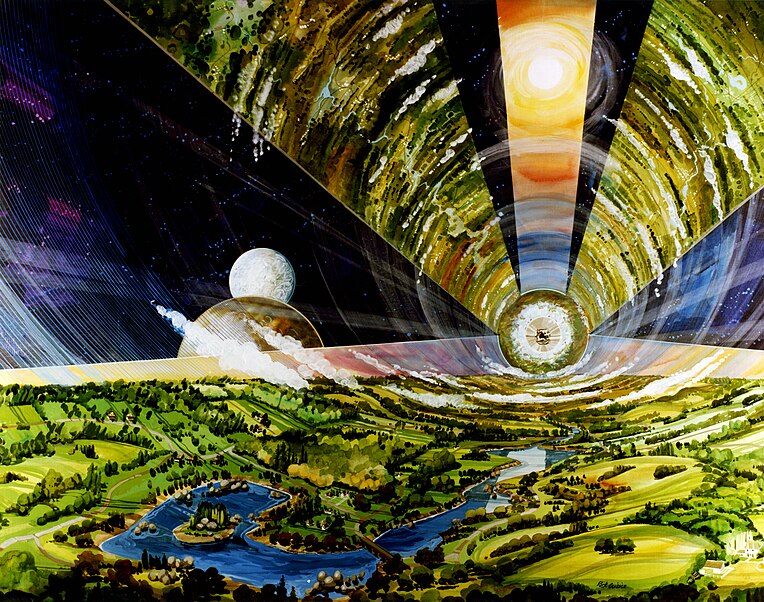Space is quite utterly big, little we know of its vastity and its dangers apart from what text books tells us to stare and avoid. The habitatat that space offers is harsh: temperatures that go well below -200 degrees Celsius (close to the absolute zero), extreeme heating from nearby stars, and gamma ray burst that will kill any human in seconds. Apart from this unpleasant side, space is a fertile "land" where humanity can build and expand, gathering new resources in order to bring ballance to planet Earth.
Take for example the space race, it gave us the possibility to experiment with long time exposure to zero-gravity of the bones, this allowed us to test the limits of the human body. Then orbital stations provided the essentil data to understand what is needed to people to live in space modules, their mental reaction along with many experiments useful to science.
To propel the human kind into a more serious and sophisticated colonization of our solar system, it is important to understand that new vessels must be built off Earth in order to take advantage of the absence of gravity, which enhance metals giving them better qualities.
Imagine these vessels with thousands of people on board traveling to other solar systems while life goes on on a daily basis. In order to colonize space we must push our technologies to the maximum so humanity can benefit from it in peaceful therms.
Some theories created in the 20th century were probably the best solution for an eventual colonization of space, here a few:
Bernal sphere

In 1929 John Desmond Bernal proposed an artificial habitat for humans where 20,000 to 30,000 people could live in a sphere orbiting on itself producing artifical gravity (Earth's gravity 1g). The original design specified the dimensions of the project with a 16 km diameter, later on Bernal reproposed a much smaller design of just 500m in diameter where people would like at the heigh of the equator, the landspace would me the same of our planet. This was one of the first idea of long-term environment for humans to live in, generations of people would live their normal life while exploring space.
O'Neill cylinder

This structure is a cylinder with a 3km diameter and 20 km in lenght. Artificial gravity is provided with the rotation of the cylinder on its longitudinal axis simulating Earth's gravity of almost 1g, this will give habitats the same condit
ions on our planet, although no motion sickness will be felt, some dropped object can be deflected by a short distance due to a total different gravity system. Three islands are built along where each of them hosts a different landscape: the first island will have people living, the second one is for agricolture providing food, while the third one is for manufacturing where a lower gravity will grant higher quality materials.
Standford torus

This is a basic idea of space habitat that can host an entire city or more. It is a ring-shaped structure hollow in the inside that spind on itself creating centripetal force, therefore simulating gravity up to 1g which will recreate a condition similar to Earth's force while spinning once a minute. This is necessary to stop decalcification of the bones due to a lack of gravity. The structure is 1.8 km in diameter (as of the original project) and it was designed to host 10.000 people. Other projects can sustain a bigger population with a greater ring dimension.
Generation ship

This type of structure is similar to those listed above. The theory behind this ship is to have thousands of people willing to live their entire life on board this vessel that is constantly travelling towards its destination. Picture a trip to a remote star where it will take 100 years or more years to reach it. This vessel will host generations that will live, work, sleep, eat and die in a self-sustaining environment similar to Earth for the sole purpose of reaching the objective of the mission. This ship will require at least 160 different individuals in order to maintain genetic diversity along the trip.
Sleeper ship

The sleeper ship is another way of space travel that can help humanity to shorten mission. It can be used along interstellar travels (between stars) where great distances need to be covered. In this case the whole crew will be but to sleep in an hibernation stage where heartbeat and life functions will be slowed to an optimal point in order to save energy on the ship. An automated guidance system will carry the vessel along its path where the crew will be waken upon arrival.
SENS

Strategies for Engineered Negligible Senescence is a theory that supports the replacement of those human parts that are decaying due to age. This will allow a certain number of astronauts to travel great distances cheating centuries of trip ahead of them. British biogerontologist Aubrey de Gray published his theories in 1999 with the book Mitochondrial Free Radical Theory of Aging.
Embryo space colonization

This type of colonization is theoretically cheaper than any of the designs listed above. This mission will be set towards Earth-like planets where a spaceship will transport frozen early-stage human embryos or the technological or biological means to create human embryos. The whole process will be handled by robots that are programmed to build structures to host the growing embryos and eventually the planning of crops to sustain life with natural foods.
1 comment:
I hope this gets some attention...
Post a Comment